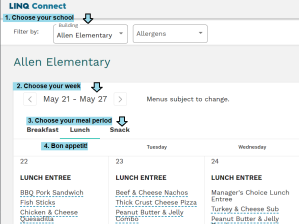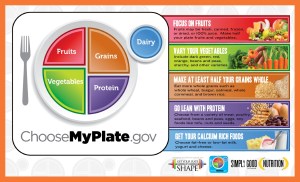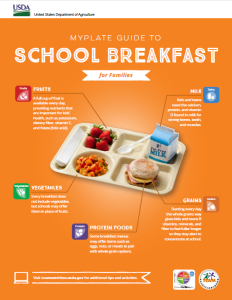Requesting an Accommodation
Due to the School Nutrition Program being regulated by different laws than the rest of the school district, a separate form and process is required in order to make accommodations in the cafeteria.
Honoring Accommodation Requests
The School Nutrition Program is required to make accommodations to a student’s meal offerings if the student has a medical or physical impairment that restricts the child’s diet. This may include students with disabilities as defined in the Americans with Disabilities Act and the Individuals with Disabilities Education Act. This accommodation can be written into the student’s Individual Education Plan and/or Section 504 plan. The School Nutrition Program will make efforts to collaborate with the School Health Team, School Counselor, and/or staff at a child’s individual school to ensure their dietary needs are met. To request an IEP or Section 504 meeting to determine eligibility, please contact your school counselor or principal. Accommodations will only be made for medically necessary reasons.
Processing the Request
All special dietary requests are processed at School Nutrition’s Central Office and must be submitted on the current Medical Request for School Meal Modifications. This form must be completed and signed by a licensed healthcare provider which may be a medical doctor, podiatrist, nurse practitioner, physician’s assistant, dentist, optometrist, or osteopathic physician. This form must be reviewed and approved by the School Nutrition Central Office Staff prior to accommodations being made.
The licensed healthcare provider must include the following information on the Eating and Feeding Form for an accommodation to be made:
- A description of the mental or physical condition/impairment(s).
- A description of how the mental or physical condition/impairment(s) restricts the student’s diet.
- A statement of the accommodation(s) requested for this student. This could include foods to avoid and substitutions, specific grams of carbohydrates required per meal for a student with diabetes.
- Licensed healthcare provider’s signature.
The School Nutrition Program will not request medical records or laboratory results, but may contact the licensed healthcare provider if the diet prescription and/or requested accommodation needs clarification.
Please note: The information on the Eating and Feeding Evaluation Form is considered a diet order or diet prescription and the cafeteria staff must follow it accordingly once submitted and approved by the School Nutrition Program. If the student’s physical or mental condition changes and the dietary restrictions subsequently change, the licensed healthcare professional must submit a new form to the School Nutrition Office. The School Nutrition Staff cannot take verbal orders from providers or parents about the change of a medical condition. Once the new form is submitted and approved by the School Nutrition Central Office staff, the new accommodation(s) will be honored. If parents no longer wants accommodations for their child, the parent may submit the request in writing.
A Note on Allergen Information Provided by the District
When sourcing new products or changing recipe ingredients, updated allergen information will be provided to schools. However, manufacturers can change ingredients or manufacturing practices without notification, and HCS cannot guarantee all allergen information will be accurate.
For More Information
For more information on special dietary requests, please contact Mallory Brearey at (423) 498-7286 or via email.


 The School Nutrition Department operates the National School Lunch Program, which is a USDA program aimed at providing healthy, affordable lunches to school students. A hungry child cannot learn!
The School Nutrition Department operates the National School Lunch Program, which is a USDA program aimed at providing healthy, affordable lunches to school students. A hungry child cannot learn! The best combination of nutrients at breakfast is carbohydrates for energy, mixed with protein to make you feel full. Milk is a great source of protein at breakfast and is available with every school breakfast. Each carton of milk contributes 1/4 of the protein a 9-13 year-old needs for the whole day!
The best combination of nutrients at breakfast is carbohydrates for energy, mixed with protein to make you feel full. Milk is a great source of protein at breakfast and is available with every school breakfast. Each carton of milk contributes 1/4 of the protein a 9-13 year-old needs for the whole day!